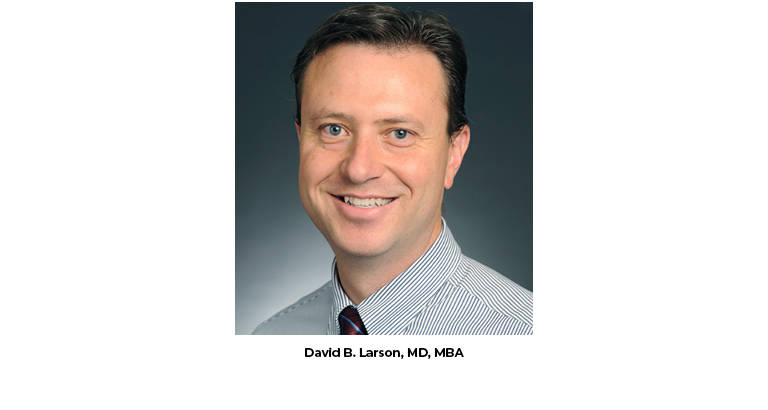“There is no better training ground for leadership, no more collaborative community, and no greater sense of accomplishment than what you will encounter in the field of quality improvement.” This is how David B. Larson, MD, MBA, chair of the ACR Commission on Quality and Safety (Q&S) and professor of pediatric radiology and vice chair for education and clinical operations practices in the department of radiology at Stanford University, feels about the field of Q&S. Larson, a national thought leader in radiology quality improvement and patient safety and a regular speaker on topics ranging from pediatric CT radiation dose optimization to radiologist peer review, recently spoke with the Bulletin about the specialty’s ongoing focus on Q&S and the opportunities ahead for continuous improvement.
What are the opportunities ahead for improving Q&S in radiology?
This is an exciting time for radiology. From its inception, our specialty has been one of almost continuous change, especially over the last several decades. The advent of AI presents many new opportunities in many areas, but I believe that as the hype fades, AI in radiology will be almost entirely about quality.
It will give us the ability to measure what was previously unmeasurable. It will give us tools to easily and broadly apply content developed by the ACR over the last several years, such as the ACR Appropriateness Criteria® (AC), Practice Parameters and Technical Standards (PP&TS), and the RADs programs. We will increasingly have both the ability and the expectation to improve our practices in meaningful and measurable ways.
Another major opportunity will be a greater emphasis on collaboration, both with each other as radiologists and with others in the medical community. This is partially facilitated by technology but also by a changing mindset within the field and across medicine. Those deepening collaborative relationships will be a true benefit to both radiologists and patients and will provide a more exciting environment to practice in.
What does continuous improvement mean?
Quality is about delivering consistent excellence. Continuous improvement is the dedication to the proposition that we can always become better. Continuous quality improvement is the processes of objectively evaluating our performance, continuing to set high goals for ourselves, and pushing ourselves to meet those goals in tangible ways. The willingness to seek feedback and then act on that feedback — to improve tools, processes, and skills that go into creating excellence — is what drives continuous improvement.
What have been the greatest accomplishments to come out of the Commission?
One thing that’s really exciting to see is the continued advancements of the various RADs programs. In the last few years, that process has moved quickly with the addition of several classification systems. Now we have an opportunity to look at those RADs development processes and see if we can make them even more systematic and useful.
In addition, the PP&TS continue to become more refined and more relevant; they provide a strong foundation on which to build AC into practice. And a heroic effort has gone into making the AC available through clinical decision support.
The ACR Accreditation program has continued to grow and make a major impact on our specialty and patient care. This is a significant driver in ensuring quality standards in practice across the country.
Finally, the annual ACR Q&S conferences have been outstanding — and they keep getting better and better every year, with greater participation, more networking opportunities, and increased focus on actionable improvement.
We are currently at the intersection of several forces that are driving the need for a relentless pursuit of quality.
Why is Q&S in radiology more important than ever before?
We are currently at the intersection of several forces that are driving the need for a relentless pursuit of quality. Imaging technology is maturing and becoming increasingly complex. At the same time, our interfaces with other parts of the medical system are growing rapidly. Not surprisingly, we find that quality tends to break down at those interfaces. Practices are becoming large, bringing a different level of scale. And lastly, AI will offer the opportunity to develop quality improvement tools that were not previously possible. These forces together will bring both the motivation and the ability to increase consistency in excellent performance. But it will not build itself; we will need to work together to bring these changes about in a way that will ensure the patient remains at the center of it all.
What advice do you have for your colleagues about getting more involved in Q&S?
I would say, especially to the younger members, that a career focused in quality improvement is extremely rewarding, albeit challenging. Quality improvement is something you can start early but takes an entire career to master — and then some. It requires a diverse and complementary skillset: engineering, design, data science, cognitive and social psychology, systems management, project management, and leadership. It will constantly challenge you, keeping you honest and humble. If it’s easy, you’re doing it wrong. But if you do it right, you can effect dramatic change that did not previously seem possible.

